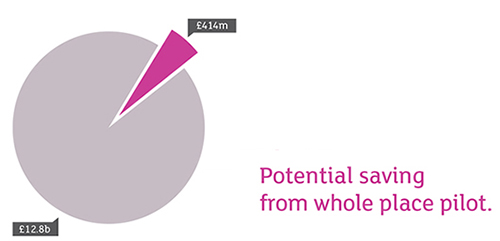Frontline services are delivered locally through an increasingly complex landscape – local authorities, NHS foundation trusts, different types of schools, social enterprises, the voluntary and private sectors. At the same time the budgets for local services are being cut – local authorities in England have suffered cuts of one third since 2010 and although NHS funding has been maintained as a proportion of GDP, pressures within the system are building. Government is increasingly requiring local bodies to work together to deliver services for example in England through health and well-being boards and the Better Care Fund), but in most cases the totality of public sector spending in local areas is unknown. The situation is similar across the rest of the UK.
Whitehall departments have been significantly reformed and reduced in size since 2010, having been cut by between 33% and 50%. But, as the Institute for Government observes, this focus on internal reform has come at the expense of attempts to get departments to work together more effectively.
The consequences of silo thinking in Whitehall are exposed most clearly in the local work carried out by departments. Initiatives such as Total Place and Community Budgets, and the time taken to deliver tangible benefits, have revealed how disjointed and incoherent centrally controlled public services have become. Information, resources and ideas are not shared, common goals are not agreed, costs are duplicated and performance is undermined. Departmental boundaries – perpetuated by both civil servants and ministers – constantly frustrate attempts to collaborate around the needs of communities.
 Aligning Spend Aligning Spend |
|
Mapping local area spending is a vital part of understanding the local delivery landscape. For example, Staffordshire and Stoke-on-Trent estimated total public sector gross revenue expenditure at some £7.5bn in 2013 for the region, of which £4.8bn is spent by the NHS and DWP. Understanding this landscape allows Staffordshire to work with partners both within and outside the county to develop shared services, resources and expertise to achieve greater efficiencies and generate income.
The Whole Place Community Budgets pilot, Whole Essex, led by Essex County Council and also covering 12 district, borough and city councils and two unitary councils, has estimated that it could save £414m over six years out of annual total public expenditure of £12.8bn. But the identified benefits go beyond cash savings – there are increased opportunities for better co-ordination and support between central and local government and co-design and co-production of plans and service delivery.

|
 Troubled Families Troubled Families |
|
The Troubled Families programme was launched in 2011 to join up efforts across central and local government. Local authority budgets were increased by £448m over three years on a payment-by-results basis with the ambition to turn around the lives of the 120,000 families in England. By March 2014, nearly 40,000 troubled families’ lives had been turned around across a number of indicators: improved anti-social behaviour, crime and education results as well as continuous employment.
The West Sussex Think Family Partnership shows how the programme works in practice. It is led by West Sussex County Council bringing together agencies including district and borough councils, police, the voluntary sector, education and health. The partnership is helping 750 families get back on track and have implemented a number of innovative approaches. One of these is ‘Think Family Neighbourhoods’, where areas of known deprivation are targeted with projects that promote neighbourhood pride, community cohesion and build skills for work.
|